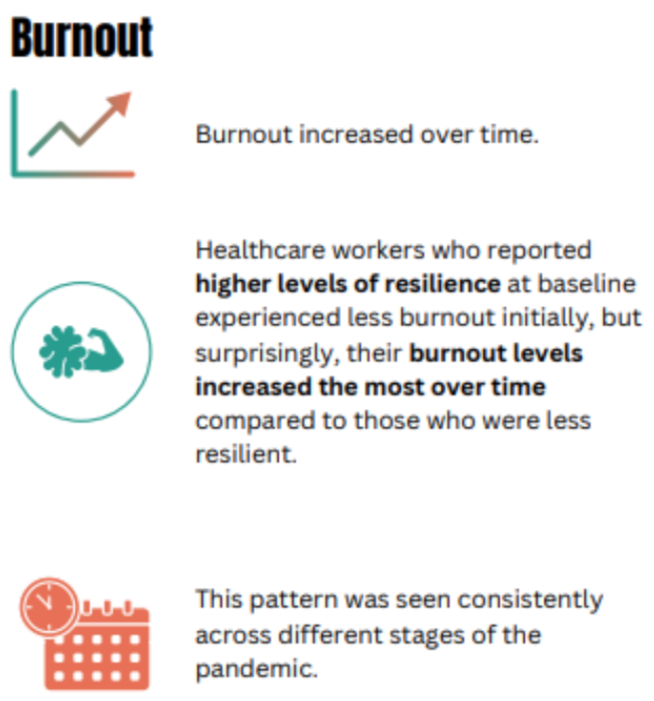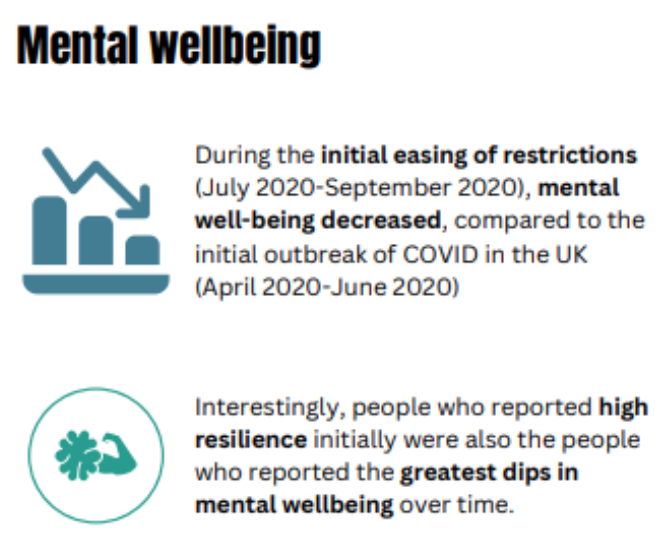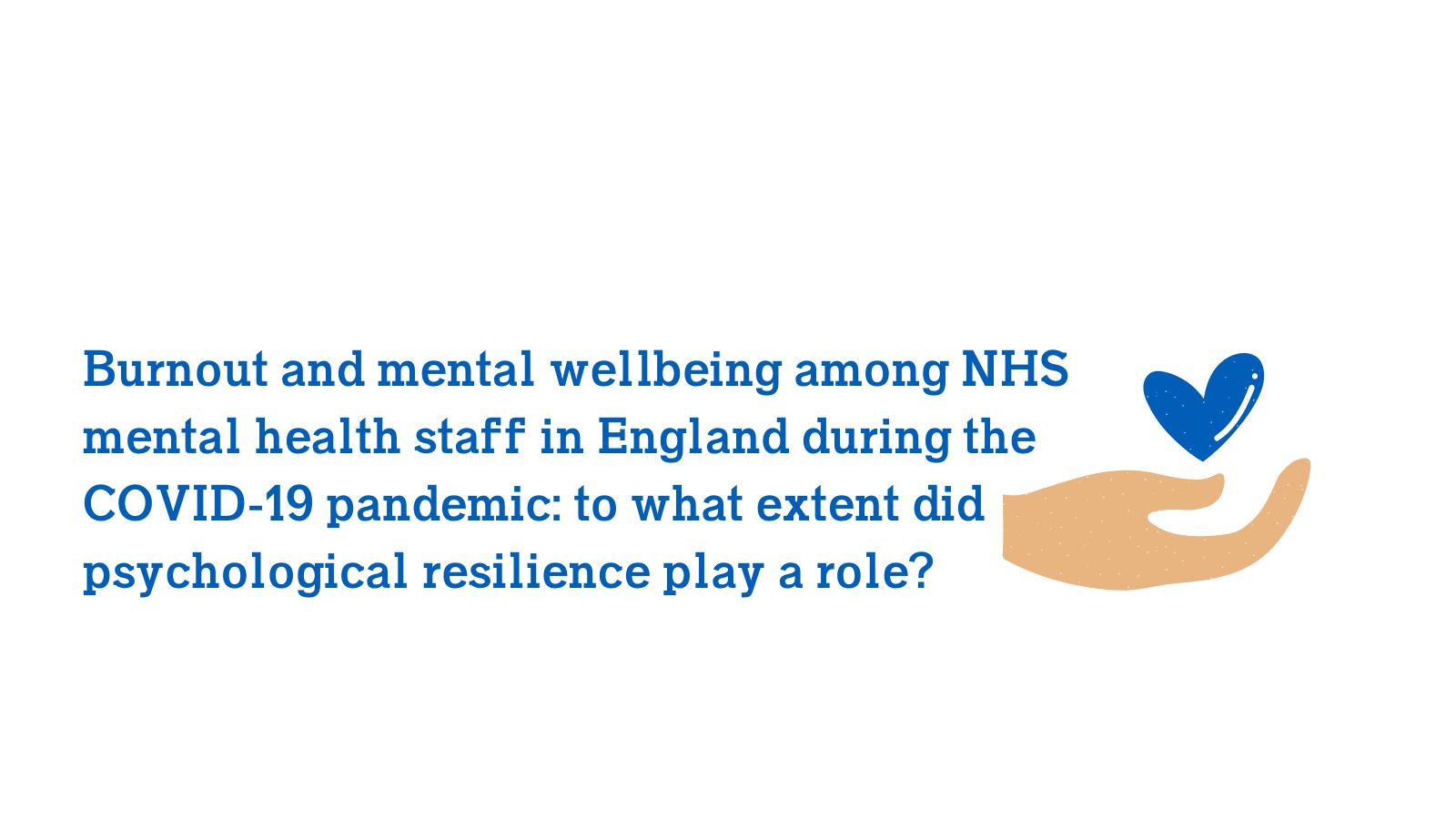By Syeda Tazrin, Bethany Croak, Neil Greenberg, Sharon Stevelink
Introduction:
Psychological resilience is defined as the ability to recover following difficult times. It is an attribute that is highly valued in society and most notably perhaps in the workplace. Job recruiters, for example, seek the ability to adapt to high-pressure and fast-paced environments. Particularly during the COVID-19 pandemic, messages about individual resilience were prominent. This is particularly the case for physically and emotionally demanding fields such as healthcare, where workers may be routinely exposed to traumatic experiences compared to other workers. The long-term impact of a ‘resilience and perseverance culture’ is naturally an interest to many, including this current study which investigated whether resilience amongst mental health workers is related to long term burnout and mental wellbeing.
What we already know:
The pandemic inevitably put a strain on the already under-resourced mental health services, the effects of which we are still seeing today, including increasing workload and a backlog of patient referrals. Burnout and resilience within the NHS workforce have therefore been of particular interest to researchers and policy makers, with the assumption being that if it is possible to increase workers’ resilience, this may reduce or mitigate burnout. However, there is mixed evidence on whether resilience can increase mental wellbeing or decrease burnout. Although some longitudinal research suggests that in the general population, those with low resilience experienced an increase in mental distress over the course of the pandemic (1), one study (2), this time with healthcare workers, found no links between (high or low) resilience at the start of the pandemic and psychological distress. This calls to question whether programmes or messages about increasing individual resilience are an effective solution for combating burnout and increasing psychological wellbeing among workers.
What we wanted to find out:
This study used data from the NHS CHECK study (3) to find out whether resilience at baseline (April 2020) predicted increased wellbeing and decreased burnout over the course of the COVID-19 pandemic (April 2020-January 2021) among 3,289 mental healthcare workers across 18 NHS Trusts in England.
The NHS CHECK study was set up early during the COVID-19 (in April 2020) to investigate the psychosocial impact of the COVID-19 pandemic on healthcare workers mental health and well-being over time.
Main findings
Here are the measures we used:
Resilience: measures using the Brief Resilience Scale (BRS), a 6-question survey where participants rate statements like “I tend to bounce back quickly after hard times” from 1 (strongly disagree) to 5 (strongly agree).
Burnout: assessed with the short version of the Burnout Assessment Tool (BAT-12), a 12-question survey that looks at exhaustion, mental distance, and emotional impairment. Participants rate statements like “At work, I feel mentally exhausted” from 1 (never) to 5 (always).
Mental Wellbeing: measured using the Warwick-Edinburgh Mental Wellbeing Scale (WEMWBS), which includes questions on emotional and functional aspects of wellbeing. Participants rate how often they felt things like “I have been feeling useful” in the past two weeks from 1 (none of the time) to 5 (all of the time).
Here is what our analysis showed:
- Burnout: burnout increased over time. Healthcare workers who reported higher levels of resilience at baseline experienced less burnout initially, but surprisingly, their burnout levels increased the most over time compared to those who were less resilient. This pattern was seen consistently across different stages of the pandemic.
- Mental wellbeing: during the initial easing of restrictions (July 2020-September 2020), mental well-being decreased, compared to the initial outbreak of COVID in the UK (April 2020-June 2020). Interestingly, people who reported high resilience initially were also the people who reported the greatest dips in mental wellbeing over time.


In summary, while high resilience seemed to protect against burnout and poor mental wellbeing initially, it did not shield against the long-term stress of the pandemic.
Implications:
Burnout increased over time: NHS mental health staff experienced a steady increase in burnout throughout the pandemic; this is consistent with challenges such as increasing workload pressures, scarcer resources and the residual effects of the pandemic such as long waiting lists, staff absences, and increased need for mental health care.
Impact of high resilience: initially, higher individual resilience appeared to help protect against burnout. However, whilst staff with high resilience had lower levels of burnout overall, they also experienced the largest increases in burnout over time.
Need for broader support: there is poor evidence for increasing individual resilience generally. There is more scope to look at how to improve teams, and ideally organisational resilience. This looks like ensuring all supervisors feel confident and competent to speak with their team members about their mental health, peer support and team based reflective practice are all likely to have more of an impact than wellbeing training or mindfulness.
To conclude, whilst fostering individual resilience may be helpful, it is clear that organisational support and addressing systemic factors are crucial to protect the wellbeing of the NHS mental health workforce during these challenging times. In other words, it is important to not constantly put the onus on individuals to change; instead, structural factors such as understaffing, access to adequate time off and staff meals are likely more important role in staff burnout and well-being. This is consistent with guidelines from the World Health Organisation (4) and NICE (National Institute for Health and Care Excellence) (5), which are regarded as the gold standards in healthcare. They emphasize that improving individual resilience is ineffective if organisational issues remain unsolved.
References
1. Riehm KE, Holingue C, Smail EJ, Kapteyn A, Bennett D, Thrul J, et al. Trajectories of Mental Distress Among U.S. Adults During the COVID-19 Pandemic. Annals of Behavioral Medicine. 2021 Feb 1;55(2):93–102. doi: 10.1093/abm/kaaa126
2. Hines SE, Chin KH, Glick DR, Wickwire EM. Trends in Moral Injury, Distress, and Resilience Factors among Healthcare Workers at the Beginning of the COVID-19 Pandemic. International Journal of Environmental Research and Public Health [Internet]. 2021 Jan 9;18(2):488. doi.org/10.3390/ijerph18020488
3. Lamb D, Greenberg N, Hotopf M, Raine R, Razavi R, Bhundia R, et al. NHS CHECK: protocol for a cohort study investigating the psychosocial impact of the COVID-19 pandemic on healthcare workers. BMJ Open [Internet]. 2021 Jun [cited 2022 Feb 28];11(6):e051687. doi:10.1136/ bmjopen-2021-051687
4. World Health Organization. Guidelines on mental health at work [Internet]. www.who.int. 2022. Available from: https://www.who.int/publications/i/item/9789240053052
5. NICE. Overview | Mental wellbeing at work | Guidance | NICE [Internet]. www.nice.org.uk. 2022. Available from: https://www.nice.org.uk/guidance/ng212

No responses yet